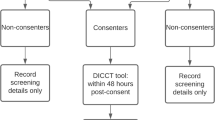Abstract
Objective
To design and develop a simple, easily readable patient information leaflet (PIL) for a commonly used antiretroviral (ARV) regimen and to evaluate its readability and acceptability in a Tanzanian population.
Method
A PIL incorporating simple text and pictograms was designed for the antiretroviral regimen of stavudine, lamivudine and efavirenz. The PIL was designed according to established good design guidelines, modified during a multi-stage iterative testing process and piloted in a South African Xhosa population. The PIL was made available in both English and Kiswahili. Sixty Tanzanian participants who were not taking ARVs were interviewed. They were asked to read the PIL in the language of their choice and were then asked a series of two-part questions; the first part required participants to locate the information in the PIL, after which they were asked to explain the information in their own words. Acceptability was assessed through close-ended questions and open-ended feedback. The influence of selected patient characteristics on comprehension of the PIL was investigated using one-way ANOVA and t-tests for independent samples with a significance level set at 0.05.
Main outcome measure
Comprehension of the written information in an overall percentage understanding.
Results
The overall average percentage comprehension of the PIL was 95%. The target set by the EC guideline that at least 80% of participants correctly locate and understand the information was achieved for 19 of the 20 questions. Five of the six instructions illustrated by pictograms were correctly understood by all participants. The only patient characteristics significantly associated with comprehension were educational level and self-reported ease of reading the PIL. Acceptability of the PIL was high and positive comments were associated with simplicity, good design, easy readability and user-friendliness, the latter enhanced by the inclusion of pictograms.
Conclusion
The PIL designed for this study was shown to be effective in communicating information about ARVs. Patient characteristics must be taken into account when developing written information, and the final document must be tested for comprehension in the target population.


Similar content being viewed by others
References
Coulter A. Evidence based patient information. BMJ 1998; 317:225–6.
Howard J., Wildman K., Blain J., Wills S., Brown D. The importance of drug information from a patient perspective. J Soc Admin Pharm 1999; 16:115–26.
Koo M.M., Krass I., Aslani P. Patient characteristics influencing evaluation of written medicine information: lessons for patient education. Ann Pharmacother 2005; 39:1434–40
Mansoor L., Dowse R. Effect of pictograms on readability of patient information materials. Ann Pharmacother 2003; 37:1003–9.
Dowse R, Ehlers MS. Medicine labels incorporating pictograms: do they influence understanding and adherence? Patient Educ Couns 2005; 58:63–70.
Schaafsma ES, Raynor DK, de Jong-van den Berg LTW. Acessing medication information by ethnic minorities: barriers and possible solutions. Pharm World Sci 2003; 25:185–90.
Buck ML. Providing patients with written medication information. Ann Pharmacother 1998; 32:962–9.
Doak CC, Doak LG, Root JH. Teaching patients with low-literacy skills. Philadelphia (JB): Lippincott Co; 1996. ISBN 0-397-55161-4
Morris LA, Aikin KJ. The pharmacokinetics of patient communications. Drug Inf J 2001; 35:509–27.
Kenny T, Wilson RG, Purves IN, Clark J, Newton LD, Newton DP, Moseley DV. A PIL for every ill? Patient information leaflets (PILs):a review of past, present and future use. Fam Pract 1998; 15:471–9.
Bradley B, Singleton M, Li Wan Po A. Readability of patient information leaflets on over-the-counter (OTC) medicines. J Clin Pharm Ther 1994; 19:7–15.
Davis TC, Mayeaux EJ, Fredrickson D, Bocchini JA, Jackson RH, Murphy PW. Reading ability of parents compared with reading level of pediatric patient education materials. Pediatrics 1994; 98:460–4.
Institute of Medicine Committee on Health Literacy. Health literacy: a prescription to end confusion. Washington, DC: The National Academies Press; 2004. ISBN 0-309-52926-3
Gustafsson J, Kälvemark S, Nilsson G, Nilsson LG. Patient information leaflets – patients’ comprehension of information about interactions and contraindications. Pharm World Sci 2005; 27:35–40.
Davis TC, Wolf MS. Health literacy: implications for family medicine. Fam Med 2004; 36:595–8.
UNESCO Institute for Statistics, Literacy Statistics (August 2005 assessment). http://www.uis.unesco.org/ev.php?URL_ID=5204&URL_DO=DO_TOPIC&URL_SECTION=201(November 17, 2005)
UNAIDS/WHO AIDS epidemic update: December 2005. http://www.unaids.org/Epi2005/doc/report_pdf.html (November 23,2005)
Tanzania Care. HIV/AIDS in Tanzania. (Fact sheet) October 2005. http://tanzaniacare.org/download/fact_sheets/AIDS_in_Tanzania.pdf 4 (November 21, 2005)
Smith SR, Rublein JC, Marcus C, Penick Brock T, Chesney MA. A medication self-management program to improve adherence to HIV therapy regimens. Patient Educ Couns 2003; 50:187–99.
Sless D, Wiseman R. Writing about medicines for people, 2nd ed. Australian Government Publishing Service: Canberra; 1997.
Dickinson D, Raynor DK, Duman M. Patient education leaflets for medicines: using consumer testing to determine the most effective design. Pat Educ Couns 2001; 43:147–59.
Koo MM, Krass I, Aslani P.Factors influencing consumer use of written drug information. Ann Pharmacother 2003; 37:259–67.
Raynor DK. Writing patient information—A pharmacist’s guide. Pharm J 1992; 249:180–2.
Medicines Control Council, Department of Health, Republic of South Africa. Guidelines on the requirements for patient information leaflets. Document 2.14MAY04V2:May 2004
USP DI. Vol. II 2000. Advice for the patient. Drug information in lay language. 20th ed. Englewood: Micromedex, Inc.; 2000
Dowse R, Ehlers MS. The evaluation of pharmaceutical pictograms in a low-literate South African population. Pat Educ Couns 2001; 45:87–99.
Mwingira B. Written medicines information for antiretroviral therapy. [MSc Dissertation]. Grahamstown: B Mwingira; 2005
Fry E. Fry’s readability graph: Clarification, validity, and extension to level 17. J Reading 1977; 21:242–52.
Sojourner R, Wogalter M. The influence of pictorials on the comprehension and recall of pharmaceutical safety and warning information. Int J Cogn Ergon 1998; 2:93–106.
Acknowledgements
The authors would like to thank Professor Sarah Radloff for her help with the statistics, and the interpreter and participants who contributed to this project.
Financial support of the study Financial support from Rhodes University and Wyeth South Africa is gratefully acknowledged.
Author information
Authors and Affiliations
Corresponding author
Rights and permissions
About this article
Cite this article
Mwingira, B., Dowse, R. Development of written information for antiretroviral therapy: comprehension in a Tanzanian population. Pharm World Sci 29, 173–182 (2007). https://doi.org/10.1007/s11096-006-9056-0
Received:
Accepted:
Published:
Issue Date:
DOI: https://doi.org/10.1007/s11096-006-9056-0




